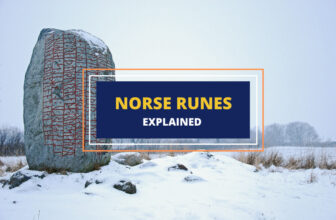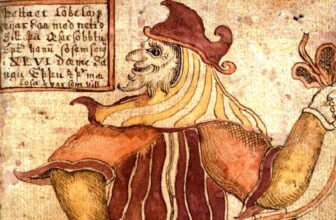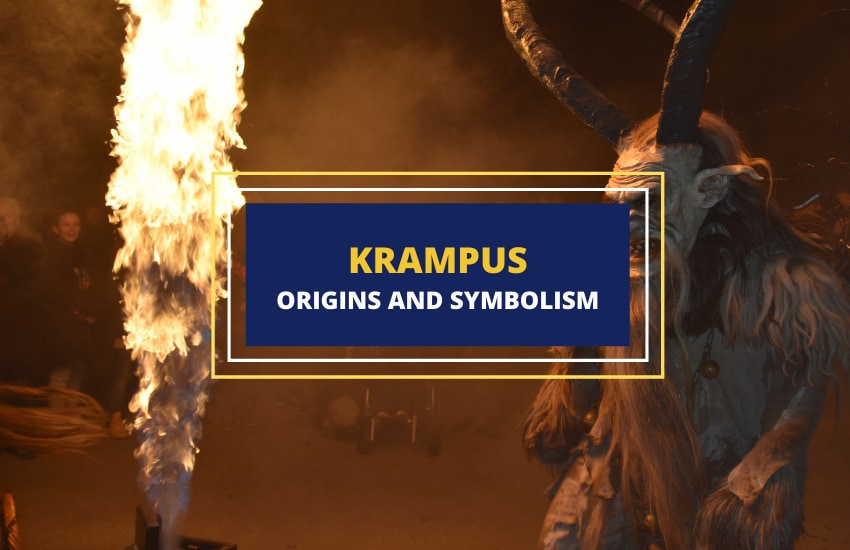
Table of Contents
Krampus is a strange mythological being with rather unique looks and symbolism. Half-goat and half-demon, this terrifying being has mysterious origins that may come from several different ancient cultures and religions in Central Europe, including the ancient Norse/Germanic mythology. Today, however, his mythology and cultural role are quite different. So, who exactly is this Christmas devil?

Who is Krampus?
Krampus’ exact origins aren’t perfectly understood yet and may never be. He certainly comes from Central Europe, today’s Germany and Austria, and he is thousands of years old. As far as we can tell, he has always been associated with pagan festivities around the Winter Solstice, today’s Christmas holiday season.
As his worship moved from paganism into Christianity, Krampus began to be associated with Christmas Eve itself. Today, he is viewed as Santa Klaus’ opposite – while the bearded old man gives presents to the kids who’ve been good throughout the year, Krampus beats or sometimes even kidnaps kids who’ve been misbehaving.
What Does Krampus Look Like?
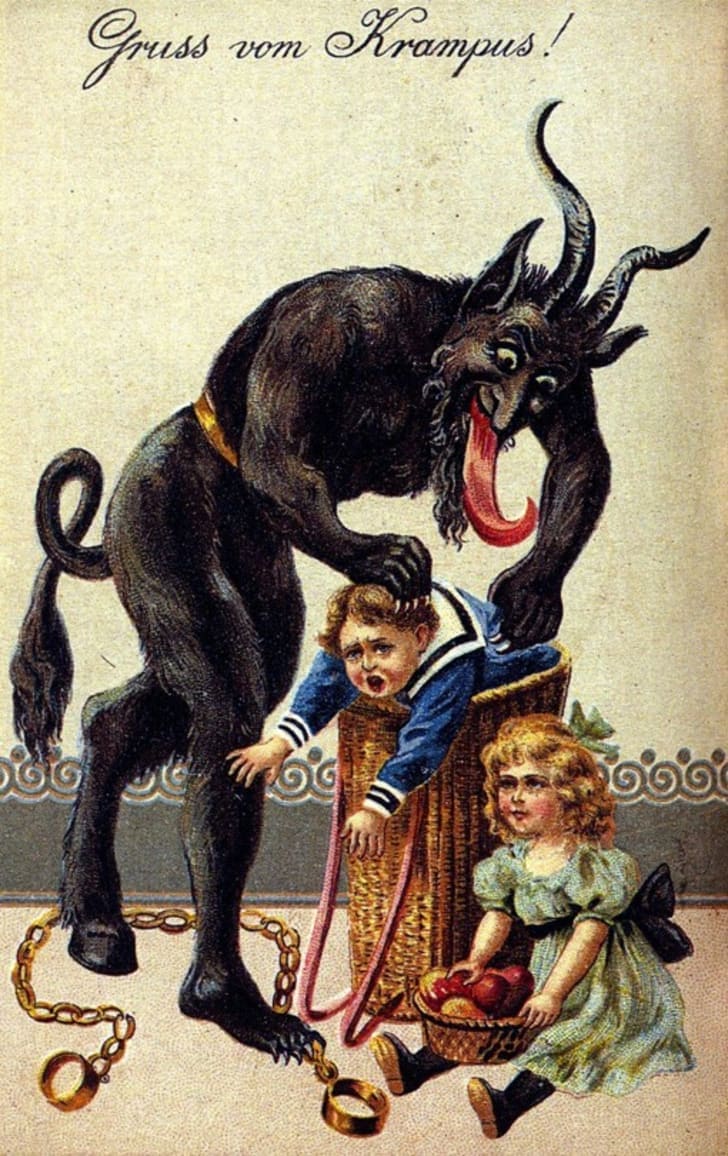
The Krampus is depicted as a half-goat half-demon with a thick furry hide, long, twisted horns, cloven hooves, and a long tongue.
But there is no single depiction of Krampus – his appearance varies. The costumes of Krampus worn at Krampuslaufs, a traditional Austrian procession, incorporate aspects of devils, goats, bats, bulls and more. The result is a terrifying amalgamation, featuring hooves, horns, hides, and lolling tongues.
Son of Hel
One of the more popular believes about Krampus’ origin is that he comes from the ancient Germanic and Norse mythologies that were widespread in pre-Christian Central and Northern Europe.
According to this theory, Krampus is the son or maybe a minion of the goddess Hel, the ruler of the icy Norse underworld. Herself a daughter of Loki, Hel is seen as a goddess of death who hardly ever left her realm. So, as her son or minion, Krampus was the one who roamed the land and punished the wicked or brought them to Hel’s realm.
While not fully supported by mainstream sources on Nordic/Germanic mythology, this theory is pretty coherent and is pretty widely accepted today.
Early Christian Worship
Ever since Christianity became the dominant religion in Europe, the church has tried to ban the worship of Krampus. Christian authorities neither wanted the horned demon to be associated with the Winter Solstice and the birth of Jesus Christ nor did they want people to use Krampus to instill morality into children. Yet, Krampus’ myth persevered in Germany and Austria.
It wasn’t long before St. Nicolas’ worship also came to Central Europe from the East. This Christian saint was also associated with the Winter Solstice, but the difference was that he rewarded good behavior instead of punishing the wicked. This naturally intertwined St. Nicolas and Krampus in the same holiday tradition.
Initially, the duo was associated with December 6 – the saint day of St. Nicolas. It was said that on the eve of December 5, the two would arrive at one’s home and judge the children’s behavior. If the children had been good, St. Nicolas would give them treats and presents. If they had been bad, Krampus would beat them with sticks and branches.
Krampus Run
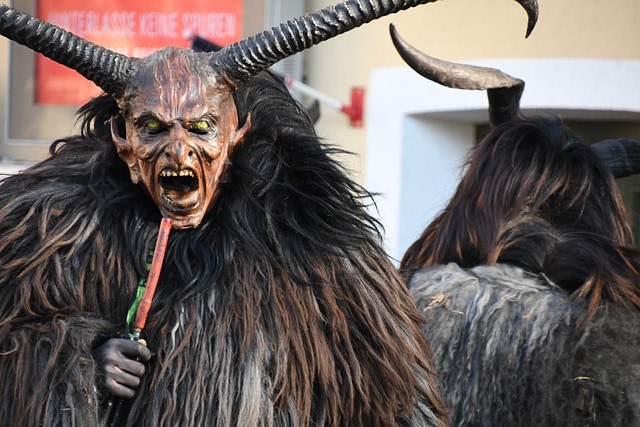
A popular tradition in Germany and Austria is the so-called Krampus run or Krampuslauf. Similar to the Slavic Kukeri tradition and other similar festivals, the Krampus Run included grown men dressing as the horrific creature before Christmas and dancing through town, scaring spectators and evil-doers alike.
Naturally, the Krampus Run has its opposition from some Christian churches, but it’s still practiced regularly.
Krampus and the Commercialization of Christmas
Eventually, St. Nicolas became Santa Claus and was associated with Christmas itself and not with his own saint day. So, Krampus also followed suit in the late 20th century and became a part of the Christmas tradition, albeit with a less popular role.
Still, the duo’s dynamic was preserved – Santa Claus and Krampus would arrive in your home on Christmas Eve and judge your children’s behavior. Based on that judgment either Santa Claus would leave presents or Krampus would start swinging his stick.
FAQ
Q: Is Krampus good or bad?
A: Krampus is a demon but he’s not strictly malevolent. Instead, he’s viewed as a primordial/cosmic force of judgment and retribution. Krampus doesn’t terrorize the good, he just punishes the wicked.
Q: Is Krampus Santa’s brother?
A: He is Santa’s counterpart and he can be viewed as an “evil brother” type of figure in modern mythology. But historically, he is not St. Nicolas’ brother. In fact, the two come from entirely different mythologies and parts of the world.
Q: Why was Krampus banned?
A: The Christian church has spent centuries trying to erase Krampus from European culture and tradition with varying levels of success or lack thereof. For example, the Christian fascist Fatherland’s Front (Vaterländische Front) and the Christian Social Party in 1932 pre-WWII Austria banned the Krampus tradition altogether. Still, Krampus returned once again near the end of the century.
The Symbolism of Krampus
The symbolism of the Krampus has changed over the centuries, but he’s always been viewed as an evil demon who roams the realm and punishes those who deserve it. In the days of the ancient Norse/Germanic religions, Krampus was likely viewed as a son or minion of the goddess Hel – a demon who did her bidding in Midgard while she ruled the Underworld.
After Christianity swept through Europe, the Krampus myth was changed but its symbolism remained the same. Now, he’s still a demon who punishes those who deserve it, but he’s viewed as a counterpart of St. Nicolas/Santa Claus. In that way, Krampus’ “worship” is much more lighthearted and isn’t taken as a serious religious ritual. Instead, he’s just an interesting cultural artifact and a story used to scare children into behaving.
Importance of Krampus in Modern Culture
In addition to his active part in modern cultural traditions such as the Krampus Run, the horned demon has also made his way into modern pop culture. A prime example is the 2015 comedy horror movie named Krampus.
There’s also the 2012 novel Krampus: The Yule Lord by Gerald Brom, the 2012 episode A Krampus Carol of the US sitcom The League, as well as multiple video games such as The Binding of Isaac: Rebirth, CarnEvil, and others.
In Conclusion
Krampus has been around for thousands of years albeit in different forms. He’s traversed several religions and cultures, and he was almost banned by far-right Christian parties in Austria and Germany during the prelude of World War II. Yet he has returned, and he is now firmly centered around the Christmas holidays where he’s viewed as the evil alternative of Santa Claus – a horned demon who punishes misbehaving children rather than give them presents.





